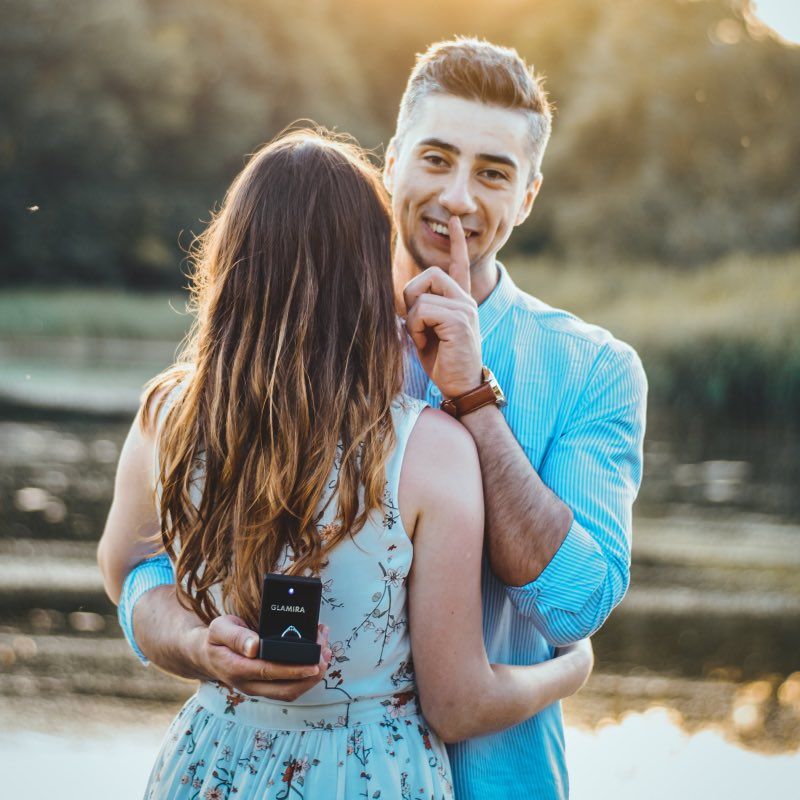Love is in the air, and there's a proposal on the horizon. Proposal photography is a niche that thrives on emotion, intimacy, and the art of storytelling. It's about capturing that unfiltered joy, surprise, and pure love when one person asks another to spend their lives together. As a proposal photographer, you're the silent observer, the hidden artist, and the keeper of treasured memories.
In this article, we'll take you through the essential steps to becoming a master of proposal photography. We'll cover how to build trust and rapport with the couples, prepare for the shoot, capture candid moments, and deliver stunning photographs that will be cherished for a lifetime.
Building Rapport with the Client
Proposal photography is all about capturing the raw, emotional, and unforgettable moments when two people decide to spend their lives together. It's an incredibly intimate experience, and as a proposal photographer, building rapport with the client is your key to success.
Establishing trust and comfort
The first step in proposal photography is gaining the trust of the soon-to-be groom. A surprise proposal photoshoot is undeniably the favored method for capturing that magical moment. Assure the proposer that you're there to document their special moment without interrupting the experience. Engage in a friendly conversation before the shoot, so he feels comfortable with your presence.
Communicating with the client during the proposal
Before the big moment, discuss with him how you'll communicate during the proposal. Should you use hand signals? Or does he want you to be discreetly close by? Understanding his preferences ensures you don't miss any important shots.
Preparing for the Proposal Shoot
The location, timing, and planning all play vital roles in ensuring a successful proposal photoshoot. Let's dive into the nitty-gritty details.
Location scouting and planning
Often, the planning process is just as important as the big day, so scout the perfect location in advance. Consider the backdrop, lighting, and potential distractions. Work with the proposer to select the ideal spot. Sometimes, a romantic setting can make all the difference.
Tip 1: Research multiple locations: Don't settle for the first location that comes to mind. Explore different potential locations that offer a variety of backdrops and moods. Consider parks, gardens, iconic landmarks, or even places that hold personal significance for the couple.
Tip 2: Plan multiple shooting angles: Identify strategic shooting positions around the location. Plan for shots that capture the couple from different angles to ensure you have a well-rounded set of photographs that tell the complete story.
Tip 3: Factor in privacy and crowds: Make sure the location allows for a private and intimate atmosphere. Consider potential distractions like crowds, construction, or events that could disrupt the proposal. Choose a day and time when the location is relatively quiet.
Timing is everything: Best times for proposals
Sunset and sunrise offer fantastic natural lighting, but the best time ultimately depends on the client's preferences. Discuss this with them to ensure you capture the moment beautifully.
Tip 1: Discuss preferred lighting: Some couples may prefer a proposal at a specific time of day to coincide with their personal preferences. In such cases, be prepared to work with the available light and adjust your camera settings accordingly.
Tip 2: Be mindful of shadows: During midday, harsh sunlight can cast unflattering shadows. If a proposal is planned for this time, scout the location to find shaded spots or have accessories like diffusers on hand to soften the light.
Tip 3: Weather contingency: Always have a backup plan in case of inclement weather. Discuss this with the client and, if possible, plan for a nearby indoor location as an alternative.
Communication with the client: Dos and don'ts
Discuss every detail with the client beforehand. Make sure they know what to expect. Keep the proposal a surprise for the other half, but ensure the proposer knows the plan to avoid any miscommunication on the big day.
Tip 1: Initial consultation: Schedule an initial consultation with the client to discuss their vision for the proposal. Learn about their story, preferences, and any specific details they want to incorporate into the shoot.
Tip 2: Keep the proposal a surprise: Emphasize the importance of keeping the proposal a secret from the person being proposed to. Discuss ways to maintain the element of surprise while ensuring that you, as the photographer, are well-prepared.
Tip 3: Clear communication: Create a detailed timeline and plan for the proposal day. Share this timeline with the client and, if necessary, with other vendors involved (e.g., event planners). Confirm all the details to ensure everyone is on the same page.
Effective communication, thorough planning, and a thoughtful approach to location and timing are key to ensuring a successful proposal photoshoot. Being well-prepared allows you to focus on capturing the beautiful, candid moments that make proposal photography truly special.
Capturing the Perfect Candid Shot
This is where your skills truly shine. As a proposal photographer, your ability to capture candid moments is your biggest asset. Here's how to capture the kind of proposal photos that are forever cherished.
Hiding in plain sight: Staying unobtrusive
Blend in with the surroundings. Use camouflage, like pretending to be a tourist taking photos of scenery or even hiding behind bushes and shrubbery. Your goal is to remain unseen to keep the moment feeling private and intimate.
Tip 1: Dress the part: Wear attire appropriate for the location. If you're shooting in a park, for example, opt for casual clothing. Blend in by looking like any other visitor or passerby. Avoid bright, attention-grabbing colors.
Tip 2: Use discreet gear: Opt for gear that doesn't draw attention. Consider smaller, mirrorless cameras with inconspicuous lenses. Avoid large, intimidating camera rigs that could give away your purpose. (And don't forget to silence your shutter sound!)
Tip 3: Timing is key: Be patient and stay alert. Anticipate the proposal moment but don't constantly look in the couple's direction. Instead, focus on something else, and be ready to quickly adjust your camera settings when the moment arrives.
Cameras, lenses, and accessories
Now onto the gear you'll need. When it comes to surprise proposals, your choice of cameras, lenses, and accessories can make a significant difference in the quality of your shots.
Tip 1: Full-frame vs. crop sensor cameras: Full-frame cameras are often preferred for proposal photography due to their superior low-light performance and image quality. However, if you're comfortable with a crop sensor camera, they can also produce stunning results.
Tip 2: Lenses for versatility: Bring a couple of lenses to capture dynamic, amazing photos. Prime lenses (with a fixed focal length) are a favorite among proposal photographers for their wide apertures, but you can also consider using a telephoto lens. This will help you capture candid moments from far away, ensuring that you're hidden and not giving away the surprise proposal.
Tip 3: Gear to keep things running smooth: Having several memory cards and backup batteries can be a real lifesaver. You don't want to miss out on any important moments because of a filled-up memory card! Also, keeping a sturdy tripod nearby is ideal, especially when dealing with low-light conditions or long exposures. Additionally, a remote shutter release or a wireless trigger can help you maintain a stable camera while keeping a safe distance during the proposal moment.
Focus and framing: Tips for composition
Keep the couple in focus, but don't forget to capture the genuine reactions of the people involved. Emotions are key, and framing is everything. Remember, it's not just about the ring; it's about the love.
Tip 1: Capture reactions: While it's essential to focus on the ring and the moment of proposal, remember to capture the moments building up to the proposal and those that follow, including the reactions and emotions of friends and family who may be present for the big surprise. These candid expressions tell the story.
Tip 2: Vary your angles: Experiment with different angles to add variety to your shots. Capture close-ups of the ring, wide-angle shots of the entire scene, and everything in between.
Tip 3: Include context: Consider the surroundings and include them in some shots. A picturesque backdrop can add depth and meaning to the images.
Working with natural lighting
Natural lighting can be your best friend, but it can also be challenging. Anticipate how it changes as the moment approaches, and adjust your camera settings accordingly. Be ready to adapt on the fly.
Tip 1: Be ready for changing light: Natural light is dynamic, so be prepared for shifting lighting conditions. Familiarize yourself with the location and anticipate how the light changes as the proposal moment approaches.
Tip 2: Fast adjustments: Understand your camera's settings well, particularly ISO, aperture, and shutter speed. Be ready to adjust these settings quickly to maintain proper exposure as the lighting changes.
Tip 3: Use light to your advantage: Pay attention to how natural light falls on the couple. Utilize soft, diffused light to create a flattering and romantic atmosphere. Position the couple so that the light enhances their features and expressions.
Post-Proposal Editing and Delivery
Your work doesn't end with the click of the camera. After the proposal, you'll need to edit and deliver the final product.
Selecting the best proposal photos
Go through your photos carefully. Select the best shots that truly capture the essence of the moment. It's quality over quantity.
Editing and enhancing the photographs
Edit the chosen shots to enhance their beauty. Adjust exposure, contrast, and colors to make the photos pop while maintaining a natural look.
Delivering the final product
Communicate with the couple about your delivery timeline. They're likely eager to relive the moment through your lens. Make sure the final product is delivered as promised.
Marketing and Building Your Proposal Photography Business
To make a successful business out of proposal photography, you need to be more than just a talented photographer. Marketing and business skills are essential.
Creating a stunning portfolio
Your portfolio is your calling card. Showcase your best work on a professional website or social media profiles to attract potential clients.
Online presence and social media marketing
Leverage social media to reach a wider audience. Share your work, engage with your followers, and use platforms like Instagram and Pinterest to showcase your talent.
Pricing strategies and contracts
Set competitive yet fair pricing for your services. Create contracts that clearly outline your terms and protect both you and your clients.
A Quick Recap
In the world of proposal photography, you have the privilege of being part of one of the most cherished moments in people's lives. Building rapport, careful preparation, capturing candid shots, and delivering the final product are all part of the package. With the right marketing and business skills, you can turn your passion into a thriving proposal photography business.
Ready to start planning your next photo shoot? No shoot is complete without a professional contract to seal the deal. That's where Indy comes in, giving you ready-made contracts that make the signing process easy. Get started today for free!




